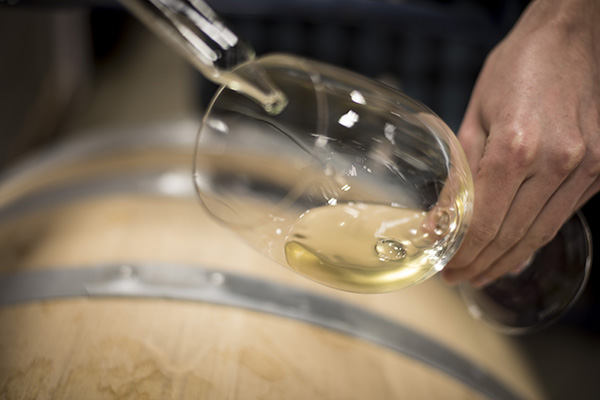Decision Time for Chardonnay

This continues a series of blog posts describing the small-lot winemaking practices at Occasio.
It’s decision time again for our 2017 Chardonnay: whether or not to add sulfites to the wine. Our Chardonnay has finished its secondary fermentation, called malolactic (ML), in which bacteria have converted the natural malic acid to softer lactic acid. With this, all of the available food for the yeast has been consumed, and the wine is, biologically, pretty stable. It is now that oxygen becomes the principal danger for our young wine going forward.
Oxidation of wine is a complex process affecting both alcohol and the polyphenols that provide color and flavor. Oxidative degradation of the phenolic compounds is responsible for the browning and loss of fruit that is observed in old wines, while the byproduct of alcohol oxidation is acetaldehyde, which gives an oxidized wine its ‘rancio’ odor. A responsibility of the winemaker is to protect the young wines from oxygen. The barrel is our first line of protection against oxidation if we keep the barrel filled to the brim (called topping). For our chardonnay, however, we will need to open the barrel at least once a month to stir the lees, so oxygen exposure is unavoidable. This is why we will be adding sulfites at this time to our barrels, continuing a millennial old practice of adding sulfites to the wine while it rests.
Oxygen reacts with iron compounds that are naturally present in wine, producing hydrogen peroxide in the process. Sulfites remove the peroxide, which prevents ethanol oxidation. That is why we will be adding sulfite to our chardonnay this week – to protect it from oxidation during its year of barrel aging. We add only a small amount, about a third of the industry standard. Nevertheless, we take any addition to our wine seriously, and always consider the latest science.
From here on, our wine will remain untouched except for stirring the lees. Late next year, we will begin preparing the chardonnay for bottling. This will require another round of decisions. We will keep you updated as the year progresses.
For the passionate wine geek interested in the biochemistry of wine oxidation:
Ribereau-Gayon (2000) Handbook of Enology Vol 2 The Chemistry of Wine: Stabilization and Treatments.
Waterhous and Laurie (2006) Oxidation of Wine Phenolics: A Critical Evaluation and Hypothesis. American Journal of Enology and Viticulture 57:306-313.


